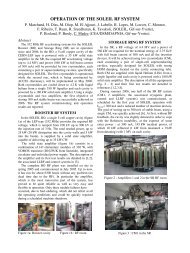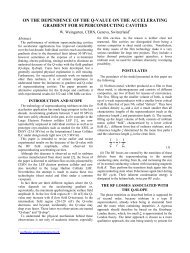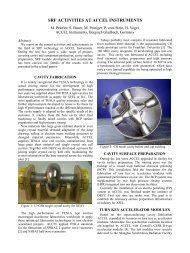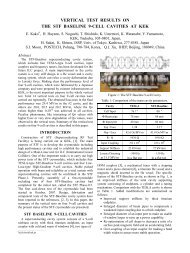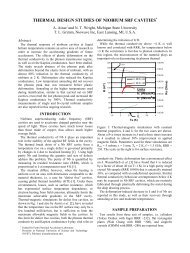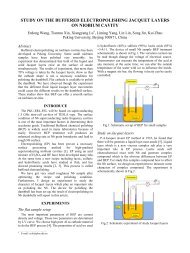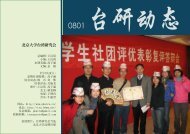niobium quarter-wave resonator development for a heavy ion re ...
niobium quarter-wave resonator development for a heavy ion re ...
niobium quarter-wave resonator development for a heavy ion re ...
Create successful ePaper yourself
Turn your PDF publications into a flip-book with our unique Google optimized e-Paper software.
≪≪≪ Poster TuP67 ≫≫≫<br />
P<strong>re</strong>sented at the<br />
13th Int’l Workshop on RF Superconductivity<br />
15–19 October 2007, Beijing, China<br />
NIOBIUM QUARTER-WAVE<br />
RESONATOR<br />
DEVELOPMENT FOR A<br />
HEAVY ION<br />
RE-ACCELERATOR<br />
W. Hartung, J. Bierwagen, S. Bricker,<br />
C. Compton, T. Grimm, M. Johnson, F. Marti,<br />
J. Popielarski, L. Saxton, R. York<br />
Nat<strong>ion</strong>al Superconducting Cyclotron Laboratory<br />
Michigan State University<br />
A. Facco<br />
Istituto Naz<strong>ion</strong>ale di Fisica Nuclea<strong>re</strong><br />
Laboratori Naz<strong>ion</strong>ali di Legnaro<br />
E. Zaplatin<br />
Forschungszentrum Jülich
Introduct<strong>ion</strong><br />
The Nat<strong>ion</strong>al Superconducting Cyclotron Laboratory<br />
(NSCL) is building a <strong>re</strong>accelerator <strong>for</strong> exotic<br />
<strong>ion</strong> beams. Stable <strong>ion</strong>s a<strong>re</strong> produced in an <strong>ion</strong><br />
source and accelerated in the NSCL coupled cyclotron<br />
facility. The primary beam produces a secondary<br />
beam of exotic <strong>ion</strong>s by particle fragmentat<strong>ion</strong>.<br />
The <strong>re</strong>accelerator will consist of a gas stopper to<br />
slow down the secondary <strong>ion</strong> beam, a charge b<strong>re</strong>eder<br />
to inc<strong>re</strong>ase the charge of the <strong>ion</strong>s by <strong>re</strong>moving electrons,<br />
a radio f<strong>re</strong>quency quadrupole to provide initial<br />
accelerat<strong>ion</strong> and focussing, and a superconducting<br />
linac to accelerate the beam to a final energy<br />
of about 3 MeV per nucleon. The superconducting<br />
linac will consist of <strong>quarter</strong>-<strong>wave</strong> <strong><strong>re</strong>sonator</strong>s<br />
(QWRs) optimised <strong>for</strong> β = 0.041 and β = 0.085.<br />
This poster covers the RF design and prototyping<br />
of the β = 0.041 QWR. The β = 0.085 QWR has<br />
al<strong>re</strong>ady been prototyped.
Experiments<br />
with<br />
fast RIBs<br />
Coupled Cyclotron Facility<br />
Reaccelerator Layout
Cavity Design<br />
The <strong>quarter</strong>-<strong>wave</strong> <strong><strong>re</strong>sonator</strong>s developed by Legnaro<br />
<strong>for</strong> ALPI and PIAVE a<strong>re</strong> the basis <strong>for</strong> the design<br />
of the QWR <strong>for</strong> the <strong>re</strong>accelerator. A slightly larger<br />
apertu<strong>re</strong> is used <strong>for</strong> the <strong>re</strong>accelerator cavities. Another<br />
diffe<strong>re</strong>nces is separat<strong>ion</strong> of the cavity vacuum<br />
from the insulat<strong>ion</strong> vacuum to <strong>re</strong>duce particulate<br />
contaminat<strong>ion</strong> of the cavity surfaces.<br />
• Shorting plate is <strong>for</strong>med from sheet Nb (3 mm<br />
thick) (similar to Argonne design) instead of<br />
being machined.<br />
• Tuning plate (1.25 mm thick) is slotted to <strong>re</strong>duce<br />
the tuning <strong>for</strong>ce (similar to TRIUMF design).<br />
• Probe couplers a<strong>re</strong> attached to the bottom flange<br />
(same as β = 0.085 prototype).
Selected QWR Parameters<br />
Optimum β 0.042<br />
Resonant f<strong>re</strong>quency f 80.5 MHz<br />
Design E p<br />
16.5 MV/m<br />
Design B p<br />
29.2 mT<br />
Design V a<br />
0.45 MV<br />
R s /Q<br />
433 Ω<br />
Geometry factor<br />
15.4 Ω<br />
Operating temperatu<strong>re</strong> 4.5 K<br />
Design Q 0 5 · 10 8<br />
Nominal OC diameter 180 mm<br />
Nominal IC diameter 60 mm<br />
Nominal height (λ/4) 931 mm<br />
Active length<br />
95 mm<br />
Apertu<strong>re</strong><br />
30 mm<br />
OC = Outer Conductor; IC = Inner Conductor<br />
ANALYST was used <strong>for</strong> numerical calculat<strong>ion</strong>s and<br />
optimisat<strong>ion</strong> of the RF parameters.
0.2<br />
0.4<br />
0<br />
3181007−006<br />
V a<br />
[MV]<br />
0.6<br />
0 0.1 0.2 0.3 0.4 0.5<br />
β<br />
Dependence of accelerating voltage on beam<br />
velocity
Fabricat<strong>ion</strong> of Prototype Cavity<br />
• Sheet Nb of thickness 2 mm and RRR ≥ 250<br />
was used.<br />
• The tip of the center conductor and the beam<br />
tubes we<strong>re</strong> machined from solid Nb.<br />
• Nb tuning plate on bottom in Nb-Ti to stainless<br />
steel flange.<br />
• Forming was done at NSCL and in local a<strong>re</strong>a;<br />
electron beam welding was done with an industrial<br />
company.<br />
• Indium joints we<strong>re</strong> used to seal the bottom flange.<br />
Knife-edge seals we<strong>re</strong> used <strong>for</strong> beam tube flanges.<br />
• c. 150 µm etch (BCP).<br />
• High-p<strong>re</strong>ssu<strong>re</strong> rinse with ultra-pu<strong>re</strong> water <strong>for</strong> about<br />
80 minutes.
Electron beam welding of β = 0.041 QWR
Nb parts <strong>for</strong> β = 0.041 QWR (top) and inside view<br />
of completed cavity (bottom)
Etching (left) and rinsing (right) of β = 0.041<br />
QWR
0<br />
Ref − S 21<br />
phase (deg<strong>re</strong>es)<br />
0.5 1 1.5<br />
3181007−005<br />
2<br />
0 50 100 150<br />
z (arbitrary units)<br />
Bead pull <strong>for</strong> β = 0.041 QWR
RF Test on β = 0.041 QWR<br />
• Vertical test with cavity immersed in liquid helium.<br />
• Multipacting barriers at low field, we<strong>re</strong> able to<br />
get through them rapidly.<br />
• Observed x-rays at high field (9 R/hour at max<br />
field); did some RF condit<strong>ion</strong>ing, but not able<br />
to eliminate the field emiss<strong>ion</strong>.<br />
• Did not observe thermal b<strong>re</strong>akdown.<br />
• Max fields: E p ≈ 80 MV/m, B p ≈ 140 mT,<br />
V a ≈ 2.2 MV.
P<strong>re</strong>paring <strong>for</strong> RF test of the β = 0.041 QWR
Q 0<br />
10 8 10 9 10 10<br />
4.6 K<br />
4.2 K<br />
2.0 K<br />
0 20 40 60 80<br />
E p<br />
[MV/m]<br />
3181007−004<br />
RF test of β = 0.041 (September-October 2007)
F<strong>re</strong>quency Issues<br />
• Measu<strong>re</strong>d <strong>re</strong>sonant f<strong>re</strong>quency at 4.5 K was too<br />
high by 225 kHz; need to cor<strong>re</strong>ct this with product<strong>ion</strong><br />
cavities.<br />
• Tuning range and tuning <strong>for</strong>ce need to be checked<br />
and compa<strong>re</strong>d with p<strong>re</strong>dict<strong>ion</strong>s.<br />
Structural Analysis<br />
• Structural analyses of the QWR a<strong>re</strong> being done<br />
with ANSYS.<br />
• Stiffening methods a<strong>re</strong> being explo<strong>re</strong>d with the<br />
aim of minimising f<strong>re</strong>quency shifts due to p<strong>re</strong>ssu<strong>re</strong><br />
fluctuat<strong>ion</strong>s and microphonics.
Conclus<strong>ion</strong><br />
• A β = 0.041 QWR has been fabricated and<br />
tested.<br />
• RF test <strong>re</strong>sults exceeded the design goals by a<br />
com<strong>for</strong>table margin.<br />
• Multipacting and field emiss<strong>ion</strong> we<strong>re</strong> observed,<br />
but they did not p<strong>re</strong>vent the cavity from <strong>re</strong>aching<br />
the design goals.<br />
• Futu<strong>re</strong> steps: product<strong>ion</strong> β = 0.041 and β =<br />
0.085 cavities <strong>for</strong> the NSCL <strong>re</strong>accelerator.


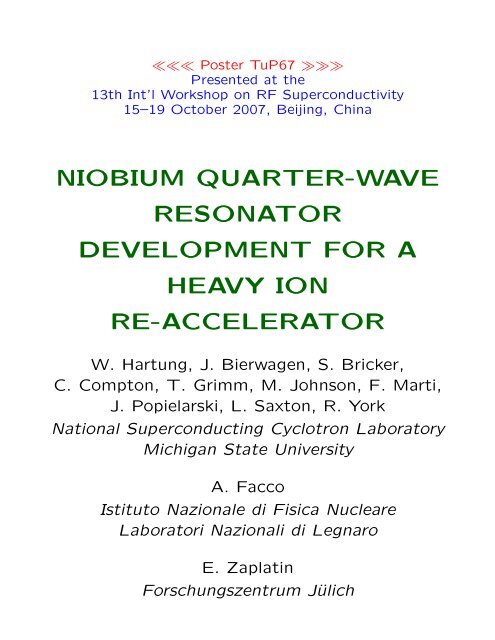

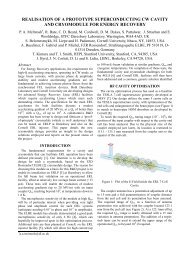
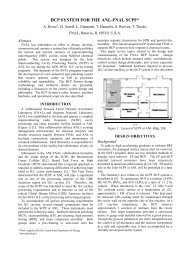
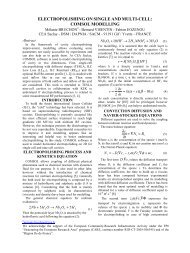

![å¨åæãæç©ä¿æ¤ææå¦ãï¼å¤§äºï¼ââå åºææååºç¨.ppt [å
¼å®¹æ¨¡å¼]](https://img.yumpu.com/42555314/1/190x135/aaaeaaeccaaeaeaea-ai-1-4-aai-1-4-aaa-aaeaeaacppt-a-1-4-araea-1-4-.jpg?quality=85)
